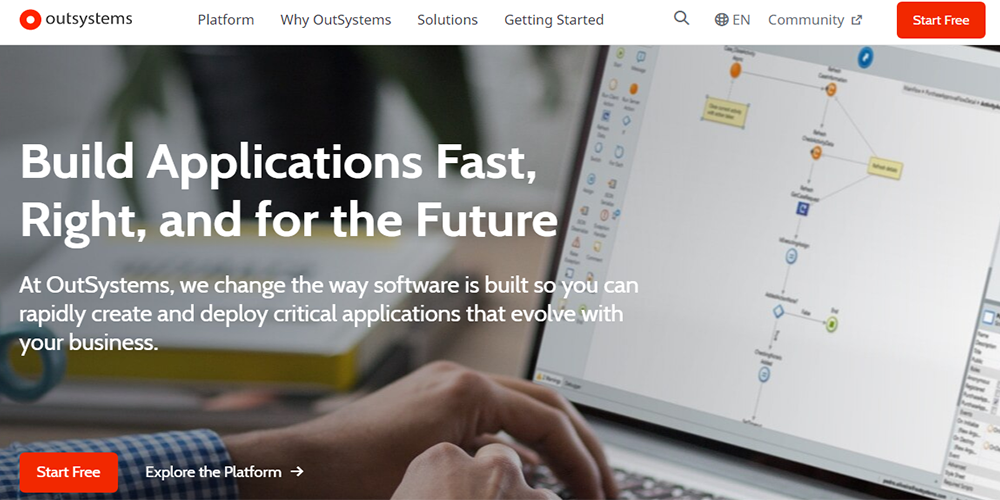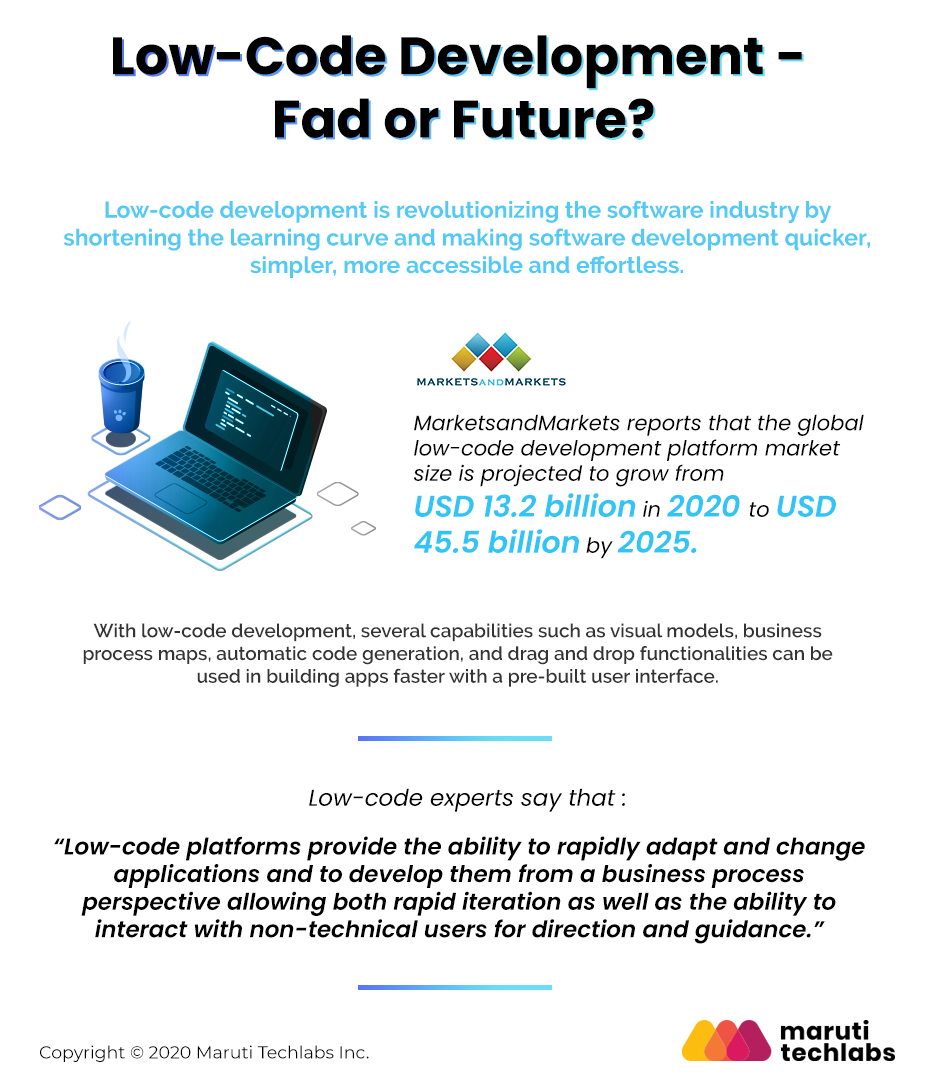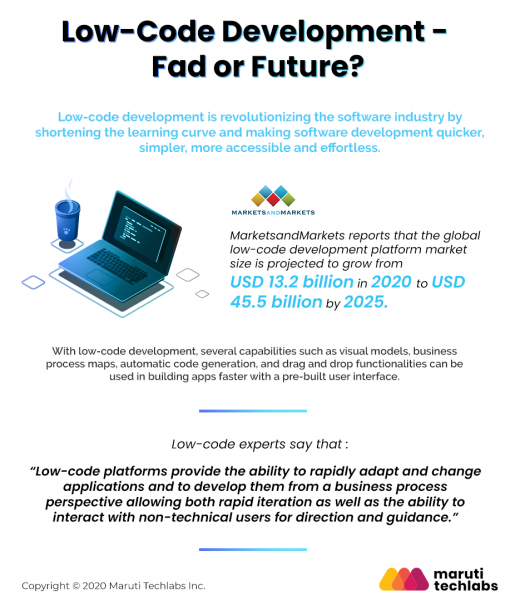How to Build a No-Code MVP
Got a brilliant startup idea but not sure if it will succeed? Develop a minimal viable product that will help you validate your idea. If it works, go ahead and get it developed. If it doesn’t, for some reason, then you can rework your concept. No-code MVP is the best way towards improving product development and growing into a successful venture.
What is MVP?
It is the basic version of the product that you build to understand your audience better. It helps the audience know the product and what to expect from it. On the other hand, it helps businesses realize the real value of the product and its feasibility.

How can you develop a product without coding knowledge? If you have a similar problem, then you don’t have to worry. Several low code platforms available online help release the first stage product without any outside help.
You gauge three things from an MVP development:
- Are your users ready for the product? Will they be interested in using your solution?
- What is the scope for scaling the product?
- Did you get enough insights from the users of the no-code MVP to invest in a full-fledged solution?
The idea is to assess a concept by translating it into a usable solution. It will help you know the future of the product idea.
Understanding No-Code MVP
Are you a business owner with no coding knowledge? A no-code MVP will get you started with the product development without hiring experts.
- No Experts On-Board: With these tools, you don’t rely on engineers or developers who are well-versed with coding. So, before you dive into actual product development, you gain insights into the end-users. You know what they want, how they use such products and improve the concept. It accelerates the launch without entering the complexities of coding.
- Need for Product: An MVP allows you to launch the teaser view of the product quickly. The idea is to understand the market and whether there is a need for such product. If people sign up for the product before the release, you know people are looking for such solutions.
Real-world MVP Use Cases
The first-ever release of Airbnb was a simple one-page website. There were no options or payments page on this site. It was merely to understand if there are users for this product. It also helped them gain three customers and $ 240 bucks at the end of the launch. However, they went through several versions before they released what we see now as Airbnb sites.
Airbnb teaches you that the MVP is the best way to know if your idea will work. However, MVP cannot be your final product. You will have to work on versions before you release the end solution.
Born out of a personal need to find a storage space that is accessible, Dropbox founder Drew Houston created a low code MVP. The idea worked with the end-users, who were happy to come aboard. However, Houston had two issues- finding the right co-founder and working on the final version with complex coding.
They also released demo videos that showcased how the product worked. Eventually, Houston found his co-founder and accelerated the development process.
From Dropbox, you can learn that creating an MVP is not enough; you also need to promote it well. The demo videos helped with the MVP promotion, which eventually resulted in a good user base.
MVP Development Cycle
To release a successful MVP, you should follow these four stages. It helps ensure the smooth and seamless release of the product.
- Conceptualize the Product: Define the product idea and the goals you aim to achieve through the development. This phase will include knowing what the competition is doing and how feasible it is for your business to create this concept.
- Map the User’s Journey: Know your customer, and map their journey from identifying needs to purchasing a product. It would be best if you started working on the MVP to make it user-friendly.
- Launch with Defined Features: Identify the user’s pain points and include features that match their requirements. You will create value when the product matches the needs.
- Tweak to Match Feedback: Once the user has started using it, you will gain insights into what is missing. Begin incorporating the feedback for best results.
Detailed Guide to Build No-Code MVP
If you are taking the no-code approach to building your MVP, this step-by-step guide will help ease the task.
Comprehensive Research
Comprehensive research identifies all the existing solutions, completes a thorough marketing understanding, and summarizes what your competition is doing. It takes the market-fit approach to decide if your product is what the users require. It is a three-question approach that you will take to complete the exploration.
- What problems have you identified?
Before you build the MVP, you would have come across issues that the target market is facing. It is impossible to solve all of them. That’s why you will research to find out the problems that you need to solve. Target the pain points that need a resolution.
- What kind of solutions exist in the market?
You are not the first one to approach these issues. Other businesses have already found some solutions to the problems defined. Complete competition analysis can help you know what products your competitors are offering.
- Who is the target persona for your MVP?
It is not enough to know the target market; you also need to know the buyer’s persona. It would help to narrow down the audience to a single personality interested in the solution. It will help create a specific and well-crafted product.

Prioritizing the Features
In case of a low code or no code development of an MVP, you should have features you want to include in the product. The goal of designing an MVP is to find out if people are interested in your product. However, you will waste a lot of time and effort to create a full-fledged product.
That’s why, after defining all the features for your product solution, identify the ones that you believe will help the MVP goals. Prioritize the functions that you think will go in the first version.
- Always include features that will solve the user’s problems
- Don’t add too many features as it will lead to complexities
- Launch the first version as soon as possible
Ascertain Success Metrics
Once you have launched the no-code MVP for your concept, it is essential to measure the success. You need to know if you can work on this idea or, you need to create a new idea.
- User Engagement: The number of users engaging with the product and the overall time spent on the page will determine if they are interested. It will help assess if the product is feasible for the audience.
- Net Promoter Score: This score will tell you whether users found the product useful or not. It will help you survey the effectiveness of the solution.
- Total Downloads: This is a clear-cut metric where you assess the idea from the total number of people who have downloaded it.
- Customer Lifetime: The total amount of time the user has spent on the app before deleting it will help determine its usefulness.
- Define the Blueprint
Once you have incorporated the feedback and assessed your idea, it is time to plan for the final product. It would help if you had a well-crafted proper blueprint that showcases the future scope of the product.
- The product’s goal is of great essence as it will tell you why you are building the product.
- The tasks and how the users will use the app will determine the success stories.
Showcase all the pain points and how the features will help overcome them through the detailed roadmap for the development.
Choose your No-Code MVP Approach
Finding a suitable no-code MVP approach for your product right at the start makes things easier for you.
-
The Prototype Approach
The idea is to create a first-version product that can help you understand the target market requirements. You will be converting your concept into a prototype to see how the people react. It will help you know if people are willing to sign up for this idea. With this approach, your idea can reach maximum people with minimal effort.
Few examples of this approach include demo videos and surveys. If people sign up for the process, they are surely going to use your product.
-
The Single Feature Approach
Instead of adding all the features and launching a full-fledged product, only to see it fail, you can create a single feature no-code MVP that will help you realize if people are looking for such solutions. You will be presenting the core function of the application. If people are on board, you can start creating the actual product.
-
The Crowdfunding Approach
Instead of beginning with the creation of the product, you can start by selling the idea. Create a crowdfunding page for the concept. Tell the users what you plan to create. When people start investing in your product, you will know there are customers out there for the solution. The sell-first, make later idea always helps collect the funds needed for the project.
-
The Landing Page Approach
The landing page offers a complete insight into the product. It talks about how the product can be used, the functionality, what makes it stand out, and why users will like it.
- Highlights the USP of the product
- Shares all the essential knowledge
- Describes the solutions that the product will provide
The landing page is a detailed insight into how the product will work. You can add a CTA that takes the user to a signup page at the end of the page. If they like it, they will sign up as beta users of your product.
-
The Email Approach
If you want to get your idea validated, the email approach is an excellent idea. You can detail out everything about your product in the email. You can ask people to sign up as beta users. It will help you evaluate the concept. It also saves a lot of time that goes into creating the product, adding the features, and then launching it.
-
The Chat Concierge Approach
If you want to collect data before you begin approaching the concept, this method works best. It allows you to chat with your potential customers, get to know their issues, and decide whether they will like the product you are offering. When you have enough data to analyze, build insights to know your user better.
Benefits of No-Code Approach
- It helps you create a minimal viable product with minimal investment and efforts. You get to gain more from the users interacting with the no-code MVP, which accelerates actual product development
- Faster feedback through better user interaction allows you to remove features that seem unnecessary for the solution
- Easy to launch newer versions by incorporating the feedback. It allows you to stay in the loop with the customer and assess the product idea
- No coding allows you to get rid of the hassles of hiring another person for the project. It saves time and cost. You can hire experts once you are ready with the concept evaluation.
Limitations of No-code Approach
Every approach has its limitations. You cannot create a no-code MVP for all ideas and situations. Let’s discuss the hurdles you would face when using this method.
- It is a continuous technique to connect with the users and seek their feedback on the product idea.
- You are required to release quick iterations after incorporating the feedback offered by the users. It is vital to stay in the loop if you want to give out an impressive solution
- Introducing a functionality is not enough; you will need to change it as per the user’s requirements. It notably doesn’t work with enterprise-grade, large-scale projects.
Mistakes to Avoid When Building a No-Code MVP
-
Creating a Complete Product
You are creating a minimal viable product. You must evaluate the concept at this point. Most business owners try to make an entire product by adding all the features possible. They want to achieve perfection the first time itself.
That’s a wrong approach. Introduce the product, its capabilities and focus on a single feature. It will help you realize if there are early adopters for the product or not. Once you have detailed insights, start working on the product.
-
Ignoring the Feedback System
You are creating the no-code MVP to gain user insights. It is essential to visualize the feedback and incorporate a defined system for quicker iterations. You need user data to be able to improve your product and further its scope. When you launch MVP, you are getting ready to know your customer better and identify their needs.
- Unclear Product Vision
Before you launch the no-code MVP, you should have a clear vision of how you want to position and scale the product. Once the no-code MVP is a success, you will keep adding new features. Loss of product vision at the next stage can lead to loss of potential and existing customers. It can also lead to massive product failure.
Conclusion
It is essential to test your vision before you launch the product. Use no-code to improve your ideas, gain insights into your target audience’s needs, and establish a high-performance product.
You don’t need an expert to get started with an MVP. It would help if you had a few online tools, a clear product vision, and the MVP goal to begin with. Be ready to launch quick iterations that can help you tap into the product’s potential and gain more opportunities.
Business & Finance Articles on Business 2 Community
(38)


